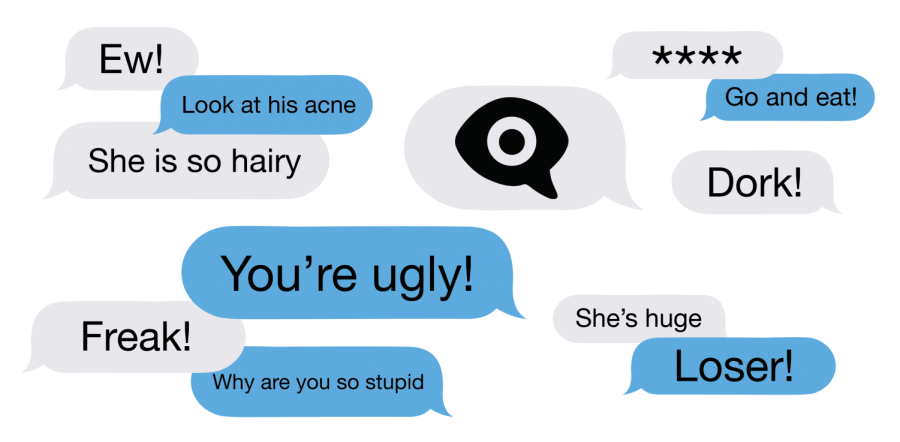It’s not just another meme: Why teens need to be conscious of hate online
Cyberbullying is normalized among teens on social media. Apple introduced the social awarenss emoji to bring attention to cyberbullying.
September 14, 2020
Quarantine halted my world and left me adrift with no schedule to dictate my day. I became attached to my phone. No matter what I was doing — eating breakfast or lunch, walking my dogs or going on a run — I always had it with me. Until online school staged an intervention two weeks into quarantine, it seemed only natural to spend several hours every day on social media. Schoolwork forced me to reintroduce some structure into my life, so I restricted my time on Instagram, TikTok and other social media apps by setting daily time limits. As I spent less time on the apps, my perspective regarding social media changed entirely.
I used to scroll mindlessly through my social media feeds, but with my self-imposed time restrictions, I began to pay more attention to the content I was consuming. I noticed that there was far more negativity than I had initially realized. What I once saw as a blur of meaningless memes and funny TikToks, I now recognized as content peppered with underlying hate.
The toxic environment of social media is almost hypnotic; as we scroll, we don’t always notice that we’re becoming desensitized to hateful and demeaning messages. In fact, 59% of teens have personally experienced some kind of cyberbullying or negative content on social media, according to a 2018 study by the Pew Research Center. As social media consumers, and especially as teenagers, we need to be aware of our participation in negative online environments and instead work toward conveying a message of tolerance.
In my observation, the most pervasive form of hateful content on social media is the extensive number of body shaming comments. Social media tends to glorify what constitutes a “good” body type — it elevates the skinny body and degrades all others. Yet, to my surprise, the comment sections don’t just feature people picking on others, but include almost as many self-deprecating jokes. I’ve seen comments ranging from “Go eat something,” or “She’s a whale,” to “I’m not going to eat for 89 days now.”
After spending too much time immersed in an environment where users only tolerate “perfect” body types, the comparison game begins — and with it comes doubt and self-consciousness. People start to sacrifice their own self-worth in pursuit of an impossible and often unhealthy standard. Being more observant of what we see on social media can help foster a society built less around the stereotype of a “perfect” body and more around the value of any healthy body.
As teenagers, we need to send a consistent message condemning intolerance by speaking out when we see hateful content on social media rather than simply staying silent. This message should extend consistently across all forms of intolerance, not only body shaming.
Memes are particularly easy to skim past because the goal of the images, GIFs and small video clips is to elicit laughter. The funny visuals and surface-level jokes, however, can blanket the underlying offensiveness of some memes. Our instinct is to immediately click, share or repost the seemingly humorous content, but sometimes being trigger-happy with the share button can do more harm than we expect. Taking a moment to understand the meme and its context can make us more aware of what we’re actually looking at.
“Holocaust memes” make up a particularly hateful category of online content. One video posted on Instagram in July 2019 depicts a cartoon skater saying, “I’d rather speak Hebrew in the 1940s than eat Lunchables with no Capri Sun.” This meme is obviously offensive. However, on Instagram, where 60-second videos reign, we often gloss over undertones of hatred. In that split second of laughter, we become enablers of hate. Having honest conversations and open dialogue about the normalization of hate — both on social media and in our community — will help us recognize when supposedly “meaningless” content can become hurtful to another person. Although this isn’t an instant solution to the toxicity of online platforms, it’s a place to begin.
Some may argue that hate is inevitable and that it’s easier to laugh at jokes than it is to take them seriously. While we may never completely eradicate hate, teenagers and all social media users have a duty to reduce its negative impact on others — and on our own mental health — by changing the dynamic of social media to one that is more inclusive and tolerant. I know that humor is one of the many ways people cope with difficult situations. I am not advocating to put an end to funny memes. Instead, I think that having a more mindful and cognizant approach to viewing them and other content can help us grow and curate a more tolerant culture online.
Our parents regale us with tales of their technological hardships: having to use a paper map or find a payphone to contact someone. Even though our challenges are different, they aren’t any less significant. Technology bombards us 24/7. It fills our feeds and our minds with hate. Only when we become conscious of hateful content and our own reactions to it will we be able to make peace with the technology that pervades our lives.








